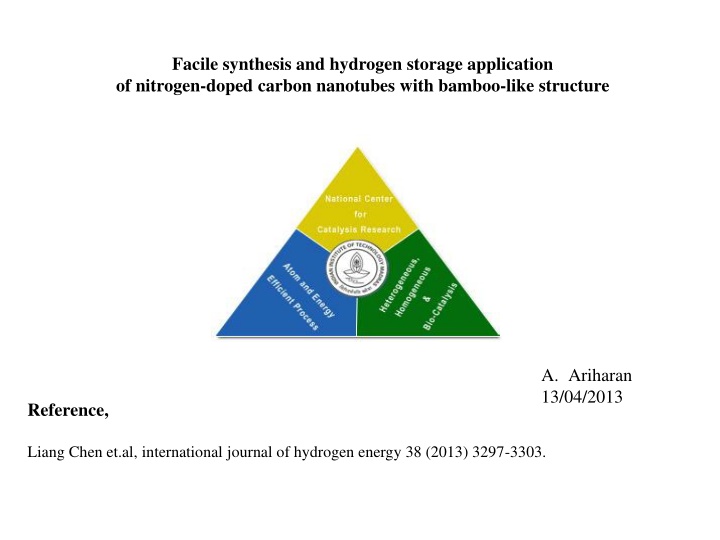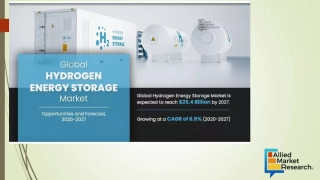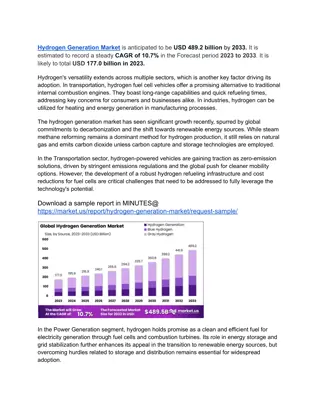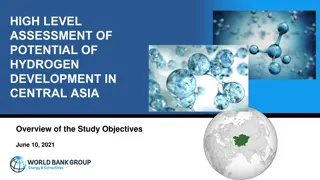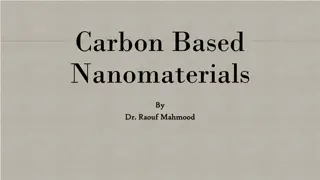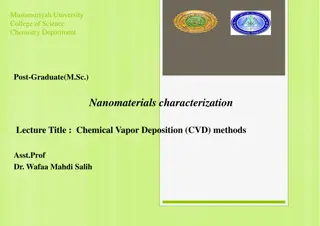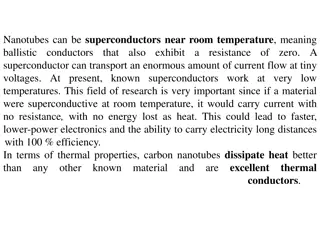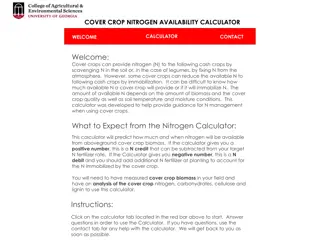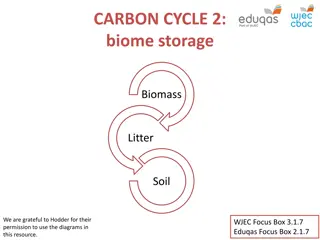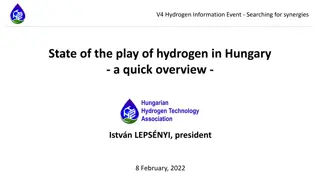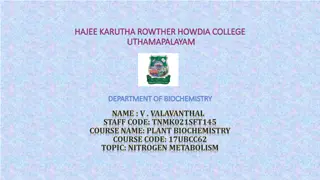Nitrogen-Doped Carbon Nanotubes for Hydrogen Storage
Hydrogen is a promising energy carrier for the future, and efficient storage under ambient conditions is a key challenge. Nitrogen-doped carbon nanotubes show potential due to their unique structure and chemical properties. This study focuses on the facile synthesis and hydrogen storage application of nitrogen-doped carbon nanotubes with a bamboo-like structure, highlighting experimental processes and characterization techniques.
Download Presentation

Please find below an Image/Link to download the presentation.
The content on the website is provided AS IS for your information and personal use only. It may not be sold, licensed, or shared on other websites without obtaining consent from the author.If you encounter any issues during the download, it is possible that the publisher has removed the file from their server.
You are allowed to download the files provided on this website for personal or commercial use, subject to the condition that they are used lawfully. All files are the property of their respective owners.
The content on the website is provided AS IS for your information and personal use only. It may not be sold, licensed, or shared on other websites without obtaining consent from the author.
E N D
Presentation Transcript
Facile synthesis and hydrogen storage application of nitrogen-doped carbon nanotubes with bamboo-like structure A. Ariharan 13/04/2013 Reference, Liang Chen et.al, international journal of hydrogen energy 38 (2013) 3297-3303.
Introduction Hydrogen has been recognized as a promising energy carrier in the foreseeable future . In the pursuit of the hydrogen energy, the efficient storage of hydrogen under near-ambient conditions remains challenging. Carbon materials are the obvious candidates for such storage, because of a combination of adsorption ability, high specific surface, pore microstructure and low mass density. Carbon nanotubes (CNTs) possess a unique hollow tubular structure, large surface area, and desirable chemical and thermal stability. Therefore, they are considered as a promising candidate for gas adsorption. Nitrogen-doped CNTs have been synthesized by various techniques, such as catalytic chemical vapour deposition (CVD), detonation-assisted CVD, template method , post-treatment of CNTs, and solvothermal route. Nitrogen doping has been considered as a feasible approach to tune the physical and chemical properties of carbon materials . The recent experimental investigations have also shown that it is possible to improve the hydrogen binding energy and hydrogen adsorption capacity of CNTs by heteroatom (nitrogen, boron and phosphorus) doping. However, to the best of our knowledge, the storage capability of hydrogen in N-doped CNTs has been rarely verified experimentally.
Experimental Pyrolysis method Mixture of melamine and FeCl3 (Molar ratio 4:1) Grinding then transferred to a Horizontal tube furnace for heat treatment (before heated the furnace under argon) The system was heated to 573 K and 773 K (5K/min) for 2 h respectively then Heated to 973 K (10K/min) for 3h under argon gas flow. Then the system was cooled to room temp Finally the product was treated with 0.5M HCl for 24 h to remove The catalyst residue then washed with deionized water and dried at room temperature
(a) SEM image of the product obtained from pyrolysis of the mixture of melamine and FeCl3 at 873 K after heating at 773 K for 2 h, b) SEM image of the N-Doped carbon nanotubes.
(c, d) TEM images and (e, f) HRTEM images of the prepared nitrogen-doped CNTs.
High-resolution XPS spectra of C 1s (a) and N 1s (b) signals of the prepared nitrogen-doped CNTs. Sp2 C-C bond in pure graphitic sites, the C atom bonded to N in an aromatic ring, and the sp2 C atoms bonded to NH2 groups pyridine-like N, graphitic-like N, and the physically adsorbed molecular N2
Nitrogen adsorption-desorption isotherm of the prepared nitrogen-doped CNTs at 77 K.
Hydrogen adsorption isotherms for the prepared nitrogen-doped CNTs (a, b) at 77 K
Hydrogen adsorption isotherms for the prepared nitrogen-doped CNTs at 298 K.
Hydrogen storage capacities of representative nitrogen doped carbon materials
Conclusion The synthesized N-doped CNTs via a facile pyrolysis of melamine using FeCl3as catalyst. The bamboo-like structure of the nanotubes has been indicated by the SEM and TEM images. The microstructure and nitrogen doping extent of the N-doped CNTs have been investigated by XPS, Raman spectroscopy, elemental analysis, and nitrogen sorption analysis at 77 K. The results show that N-doped CNTs with N doping concentration of 1.5 at%, specific surface area of 135 m2 /g, and pore volume of 0.38 cm3 /g was obtained. This approach provides an easy route to prepare N-doped CNTs. Furthermore, the N-doped CNTs has been confirmed to have excellent hydrogen storage capacity. The maximum hydrogen uptakes of 1.21 wt.% at 77Kand 7 bar and 0.17 wt. % at 298 K and 19 bar. The room temperature hydrogen storage capacity is among the highest data reported for the N-doped carbon materials under relative low pressure This result suggests the great potential of nitrogen-doped CNTs for hydrogen storage. Further work will pay more attention on the control of nitrogen doping extent and the hydrogen storage at high pressure of the N-doped CNTs.
